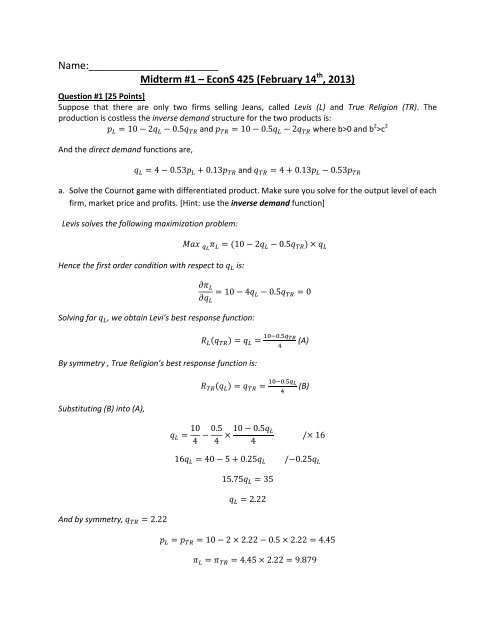You also want an ePaper? Increase the reach of your titles
YUMPU automatically turns print PDFs into web optimized ePapers that Google loves.
Name:_______________________<strong>Midterm</strong> <strong>#1</strong> – EconS 425 (February 14 th , 2013)Question <strong>#1</strong> [25 Points]Suppose that there are only two firms selling Jeans, called Levis (L) and True Religion (TR). Theproduction is costless the inverse demand structure for the two products is:and where b>0 and b 2 >c 2And the direct demand functions are,anda. Solve the Cournot game with differentiated product. Make sure you solve for the output level of eachfirm, market price and profits. [Hint: use the inverse demand function]Levis solves the following maximization problem:Hence the first order condition with respect tois:Solving for, we obtain Levi’s best response function:(A)By symmetry , True Religion’s best response function is:(B)Substituting (B) into (A),And by symmetry,
. Solve the Bertrand game with differentiated products. Make sure you solve for the market price.[Hint: use the direct demand function]Levis maximizes the following profit functionHence the first order condition with respect tois:Solving for, we obtain Levi’s best response function:(I)And by symmetry, True Religion’s best response function is:(II)Substituting (II) into (I),By symmetry,c. Which market structure, a Cournot or a Bertrand, would yield a higher market price? How wouldchanging the degree of product differentiation affect the relative difference between the twomarket-structure outcomes?P C =4.45>4.30=P B , hence Cournot yields a higher market price. The more differentiated the products are,the smaller the difference between the Cournot and Bertrand prices.
Question #2 [25 Points]In Ben Barber there are two suppliers of distilled water, labeled firm A and firm B. Distilled water isconsidered to be a homogenous good. Let p denote the price per gallon, q A quantity sold by firm A, andq B the quantity sold by firm B. Firm A and firm B bear unit production costs of c A = $20 and c B = $100 perone gallon of water, respectively. That is, firm A is more efficient than firm B. Ann Barber's inversedemand function for distilled water is given byp = 140- 2Q = 140 - 2(q A + q B )where Q = q A + q B denotes the aggregate industry supply of distilled water in Ben Barber.a. Assuming that the firms compete in prices p A and p B , write down each firm's price best responsefunction, and solve for the price each firm sets in a Bertrand-Nash equilibrium. [Hint: the bestresponse function must also consider the monopoly price]A's monopoly price can be found by solving MR = 140- q m A = c A = 20 yielding q m A = 30 and hence p m A =$80.B's monopoly price can be found by solving MR = 140 - q m B = c B = 100 yielding q m B = 10 and hence p m B =$120.Hence, the firms’ best-response functions are:Therefore, the unique Nash-Bertrand equilibrium is pbA = $80 and pbB = $100. The corresponding profitlevels are ∏ A = (80 - 20)30 = $1800 and ∏ B = 0.b. Suppose that firm B invests in R&D and manages to reduce its unit production cost to c B = $60.Firm A's unit cost stays the same, c A = $20. Consider a sequential quantity game in which firm Bsets its output level q B before firm A sets q A . Compute the Stackelberg equilibrium output andprofit levels of the two firms.In stage II, firm A solvesIn stage I, firm B solves,Thus, q A = 25, Q = 35, p = $70, so∏ A = (70 -20)25 = $1250 and ∏ B = (70 - 60)10 = $100:
Question #3 [25 Points]The demand function for concert tickets to be played by the Ann Arbor symphony orchestra variesbetween nonstudents (N) and students (S). Formally, the two demand functions of the two consumergroups are given byq N = 7,290(p N ) -3 and q S = 40,960(p S ) -4Assume that the orchestra's total cost function is TC(Q) = 6Q, where Q = q N +q S is to total number oftickets sold. Compute the concert ticket prices set by this monopoly orchestra, and the resulting ticketsales, assuming that the orchestra can price discriminate between the two consumer groups, say byrequiring students to submit their student ID cards. [Hint: MR=P(1+1/ε), where MR denotes marginalrevenue and ε is the demand elasticity]In the market for nonstudents,To find the amount of tickets sold to each group, solveQuestion #4 [25 Points]Please show that if the medium of exchange is continuous and if two firms have the same cost structure,(c₂=c₁≡c), then a Bertrand equilibrium is p₁ B =p₂ B =c.Page 110 Shy’s textbook.
















